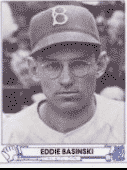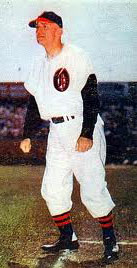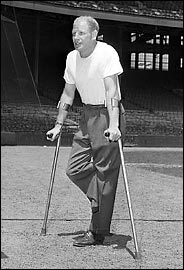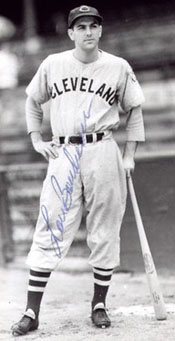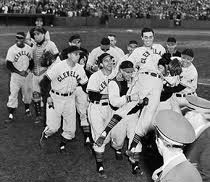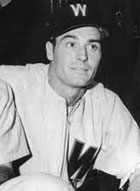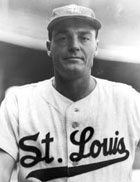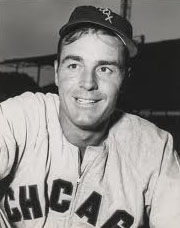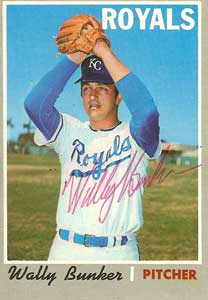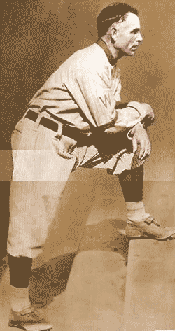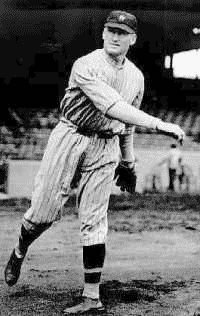One
Great Year Archive – III
This
feature discusses a season in which a team finished much higher than they
did in the immediate past or future or a player far surpassed any other
year of his career.
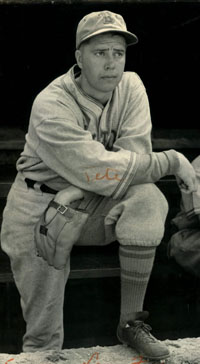
Lou Fette
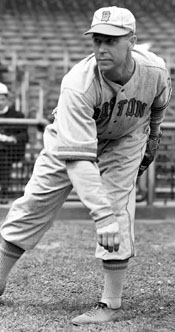
Jim Turner
|
RHP Lou Fette joined the Boston Bees for the 1937 season at age 30.
- Lou had toiled in the minor leagues for ten years starting with one year at the A level, then nine more at AA - the highest classification at the time.
- His 25-8 record at St. Paul in 1936 earned him a promotion to Bill McKechnie's Bees.
- A quiet, hard-working, poised pitcher, the Alma MO native astounded the baseball world by winning 20 games to help the Boston NLers capture fifth place at 79-73 after 8th (last) and 6th place finishes the previous two years.
Lou never came close to replicating his rookie season.
- He fell to 11-13 in '38, then 10-10 in '39.
- After Fette started 0-5 in '40 with a 5.09 ERA, Boston put him on waivers on June 21 (exactly a year before this writer's birth).
- Brooklyn picked him but jettisoned him after only two games and three innings pitched.
- Fette pitched in five more ML games with one start in 1945 for Boston, losing two with no victories and a 5.73 ERA.
- Thanks to his marvelous '37 season, he finished with a 41-40 record for his five-year big league career.
Fette would have been the top human interest story of 1937 all by his lonesome except that he had a teammate who mirrored his situation.
- Jim Turner was three years older than Fette when he joined the Bees in 1937 for his first ML season.
- Also a right-hander, Jim had begun his professional career in 1923 at Paris TX. He too had spent a long time at AA, seven years to be exact.
- An 18-13 mark at Indianapolis in '36 with a 3.89 ERA earned Jim an invitation to the Bees spring training.
Amazingly, Turner also won 20 games, losing 11.
- The press refers to the duo as the Braves' "old man pitchers."
- But, like Lou, Jim never came close to 20 wins again, although the remainder of his career is more successful as he chalked up 14 triumphs in '38 against 18 defeats.
- When he finished 4-11 in '39, Boston traded him to Cincinnati where he contributed to the Reds 1940 pennant with a 14-7 record and 2.89 ERA.
- He started Game 3 of the World Series against the Detroit Tigers but gave up 5 runs in six innings in the 7-4 defeat.
- He never won more than six games in a season for the remainder of his career which continued through the war to 1945, the last three campaigns coming with the Yankees.
- He made a one-inning appearance for New York in the '42 Series against the Cardinals.
Jim became one of the first full-time pitching coaches in the major leagues and set a high standard for the position.
- He spent 1949 through 1959 with the Yankees, during which they won nine AL pennants and seven World Series.
- He managed in the minors for one season before becoming pitching coach for another of his old teams, the Reds, helping them win the '61 NL pennant.
- He remained with Cincy for four more seasons, then returned to the Yankees as pitching coach from 1966-73 under Ralph Houk.
|
Disenfranchised All-Stars of 1945
The 1945 All-Star Game was cancelled due to wartime travel restrictions. This deprived a few players who had career years from enjoying their only chance to participate in the Mid-Summer Classic.
- LHP Roger Wolff of the Washington Senators finished 20-10. He has already appeared in this series.
- At mid-season CF Goodwin "Goody" Rosen was hitting .363 for the Brooklyn Dodgers.
- He finished the season with these stats: .325, 75 RBI, 12 HR – all by far his personal highs in a ML career that covered parts of six seasons
- With the war over in time for the '46 season, Pete Reiser returned to reclaim his CF spot in Ebbets Field. Rosen was dealt to the New York Giants and didn't play another ML game after that season.
- P Charles "Red" Barrett was traded from the Boston Braves to the St. Louis Cardinals on May 23, 1945, for C Walker Cooper.
- Red won 21 games for the defending NL champion Redbirds to go with the two he won for the Braves. That gave him 11 more victories than in any other of his 12 NL seasons.
- He stayed with the Cardinals in '46 but won only three games.
- In '47, he went back to Boston for three more years.
- The Cardinals obtained Elvin "Buster" Adams from the Phillies on June 1, 1945.
- Patrolling CF for St. Louis, he finished third in the NL with 22 HR, fifth in RBI with 109, and second in total bases with 279. He even finished 18th in MVP voting.
- Adams contributed as a pinch-hitter for the '46 pennant-winning Cardinals although he didn't appear in their seven-game World Series triumph over the Red Sox.
- He went back to the Phils in 1947, hitting .247 in his ML swansong.
- Nick Etten performed ably with the Yankees in the talent-depleted 1943 and 1944 seasons.
- The 1B drove in 107 and hit .271 to finish seventh in the 1943 MVP voting.
- In '44, he led the AL in HRs with 22 and in walks with 97. His .293 average was the highest of his career. Yet he had still not made the All-Star team.
- The next season, at age 31, Nick came close to the Triple Crown. He led the AL with 111 RBI, finished second in HR with 18, and hit .285 to finish behind only Snuffy Stirnweiss's .309 mark.
- He stayed with the Yanks in '46 but his numbers dropped off considerably. He played 14 games with the Phillies in '47 to close out his career.
- Eddie Basinski, SS for the Dodgers, was hitting .299 at the All-Star break and might have made the All-Star team as a backup to Marty Marion. Eddie's background is interesting in two respects that show how desperate clubs had become for players late in the war.
- He was signed after a tryout by the Dodgers out of the University of Buffalo even though he hadn't played baseball in either high school or college.
- Eddie spent the off-season as a violinist with the Buffalo Philharmonic Orchestra.
- Basinski, who had played in 39 games for the Dodgers in '44, tailed off in the second half of the '45 season to finish at .262 in 108 games.
- When PeeWee Reese returned from the service to reclaim his SS spot in '46, Eddie was sent to the minors and traded that December to the Pirates. He appeared in his last 56 ML games for Pittsburgh in '47.
Reference: "Disenfranchised All-Stars of 1945," Charlie Bevis, The Baseball Research Journal, 1994 | Top
of Page |
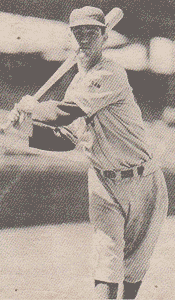
Goody Rosen
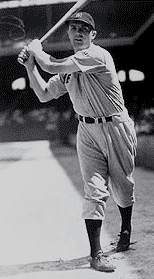
Nick Etten
|
|
One
Great Year: Gene Bearden 1948
Gene Bearden's path to the majors is a story of courage and perseverance.
- The native of Lexa AK grew up in Tennessee with Lou Gehrig as his idol.
- He began pitching in the minor leagues in 1940 at age 19.
- Like almost all prospects at that time, his career was interrupted by service in World War II.
Bearden suffered a serious injury while serving on a cruiser in the South Pacific in 1943.
- Three torpedoes struck the USS Helena, eventually sinking it. Machinist's Mate Bearden survived but with his head smashed open and a knee a mass of wounded flesh.
- Drifting in a life boat, he was picked up by a destroyer and spent the next two years in the hospital.
- Surgeons removed some cranial bones and fitted him with a silver replacement. They also inserted a metal hinge in his damaged knee.
- He suffered for the rest of his life with chronic headaches and intermittent optical incidents.
- He self-medicated by drinking ethanol, which made him an alcoholic with all the attendant problems that disease causes.
Gene returned to baseball in 1945.
- He removed any doubts about whether he had recovered sufficiently by winning 15 games at Binghamton of the Eastern League in 1945 and 15 more for Casey Stengel at Oakland in the AAA Pacific Coast League in 1946. Casey recommended Bearden to his friend Bill Veeck, owner of the Cleveland Indians.
- So the minor league P was included in a trade between the Yankees and Cleveland in December 1946.
- He pitched again for Oakland in '47, winning 16 more to earn an invitation to spring training with the Indians the following season.
The pitch that gave Bearden his chance was the knuckleball, which he had practiced since he was a kid.
- Today, his out pitch would be called a "knuckle curve."
- He also threw sliders, sinkers, and changeups. But hitters saw the knuckler 70-80% of the time.
- Because it's thrown without spin, the knuckleball can be very effective because its movement is unpredictable. But that same phenomenon also makes it unreliable.
Gene's knuckler worked in 1948 as he capitalized on the fact that he was new to the league and one of the few southpaw knuckleballers.
- The 27-year-old rookie started the season in the bullpen on a staff headed by Bob Feller and Bob Lemon.
- But player-manager Lou Boudreau started him in the 12th game in Washington.
- Veteran 3B Ken Keltner advised Bearden to "Let them hit it" because of the huge OF distances at Griffith Stadium. Gene followed instructions and won 6-1.
- He ran off three more wins before losing four in a row. But Boudreau stuck with him, and Bearden won eight of his next twelve.
From September 16 on, with the Indians in third place 2.5 behind the Red Sox and 1 under the Yankees, Lou started Gene in five of the remaining 15 games.
- The southpaw won all five games, and the Indians needed every last victory.
- September 16: Washington 6-3
- September 20: Philadelphia 6-3
- September 25: @Detroit 9-3 to tie the Red Sox for first
- September 28: Chicago 11-0 on two days rest
- October 2: Detroit 8-0, again with two days rest
- Cleveland finished in a tie with Boston, necessitating the first playoff in American League history.
- Boudreau had no hesitation in choosing Bearden to start the game in Boston with only one day's rest. As Lou explained years later:
Bearden was my best pitcher -- better than Bob Feller, better than Bob Lemon, better than Steve Gromek. He'd come through in the tough games for us all season, and I had absolute confidence in him.
Bearden was calm and collected before the big game.
- He said later that he felt more nervous before his first-ever pitching assignment.
- "He frustrated the Red Sox with his herky-jerky motion and his dead-fish-diving knuckleball" to win 8-3.
- Arthur Daley summarized the contest in the New York Times:
High-powered masterminding strategic concepts and Machiavellian managerial maneuvering are awesomely impressive when they work. Marse Joe McCarthy carefully studied the wind which blew out toward the short left field fence today and abandoned all notions of using his stylish southpaw, Mel Parnell. Instead he gambled on the ancient Denny Galehouse, a cutie on the hill who uses guile in place of speed. However, Lou Boudreau, who probably doesn’t know anything, risked everything on his stylish young southpaw, Gene Bearden. Fenway Park is supposed to be poison on left-handed pitchers, particularly when the wind blows the wrong way. But Bearden fed the poison in large doses to the Red Sox and killed their pennant hopes.
That victory alone, his 20th of the season against seven losses, would have been enough to give Gene a permanent spot in the Cleveland Pantheon. But he added to his legend in the World Series.
- With the Series tied one game apiece, Bearden tossed a two-hitter to shut out the Boston Braves in Cleveland, 2-0, in a snappy 1:36.
- In the sixth game at Braves Field, Bearden relieved Lemon with the bases loaded and one out in the bottom of the eighth and Cleveland leading 4-1.
- After Clint Conatser's SF plated a run, Phil Masi doubled in another.
- With the tying run on third, Gene got Mike McCormick to ground out.
- In the ninth, Gene walked the first batter but got Sibby Sisti to ground into a DP. Tommy Holmes' fly ball gave the Indians their first World Series championship since 1920.
Gene led the AL in ERA with a 2.43 mark. He finished second in the Rookie of the Year voting to Alvin Dark of the Braves.
Veeck and Boudreau looked forward to many more productive years from their southpaw. But he would win only 25 more games scattered across five seasons.
- The Cleveland 1B, Eddie Robinson, recalled in his autobiography Lucky Me: My Sixty-Five Years in Baseball that the seeds of Bearden's demise were sown even before his fabulous rookie season came to a close.
Near the end of the 1948 season we were playing the A's in Philadelphia, and Gene Bearden was pitching for us. Eddie Joost, an intelligent hitter who drew a lot of walks, reached first base. During a brief delay, Eddie said to me, "You know, we're stupid to be swinging at that knuckle curve Bearden throws because it's always a ball." Joost was right; the pitch came to the plate about knee high and quickly broke down and out of the strike zone. Word got around, and the hitters stopped swinging at that pitch after the '48 season. Bearden was never again as effective.
- Nevertheless, Gene started strong in '49, winning his first three starts. Then he pulled a hamstring and tried to come back too quickly. As a result, he went 5-8 the rest of the season and ended with a whopping 5.10 ERA.
- When he started 1950 1-3/6.15, Cleveland put him on waivers and send him to Washington, where he posted a 3-5 mark.
- He made the rounds of three more clubs the next three seasons, each franchise hoping he would recapture the magic of '48, but he never did: Detroit 3-4/4.33, St. Louis Browns (where he reunited with Veeck) 7-8/4.30, and Chicago White Sox 3-3/2.93.
- In 1964, Mel Harder, who was Indians pitching coach in '48, said: It took the league a year to learn to lay off that pitch, so that Gene would fall behind and have to throw his fast ball. Gene didn't have enough to win without that knuckler.
For his one brilliant season, fans elected Bearden to the Cleveland Hall of Fame as one of the top 100 players in franchise history. But his greatest awards were the scars he bore from serving his country as part of "the Greatest Generation."
|
|
Reference: " Gene Bearden," Ralph Berger, SABR Baseball Biography Project (sabr.org)
"When the Knuckleball Goes ...," The Platoon Advantage 12/22/10
Top of Page
Ned Garver 1951 - I
This
feature discusses a season in which a team finished much higher
than they did in the immediate past or future or a player far surpassed any other year of his career.
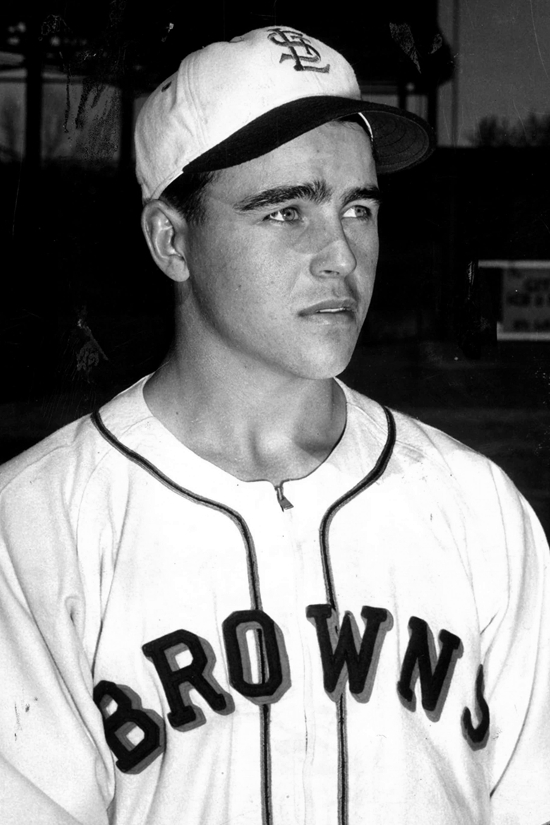
Ned Garver
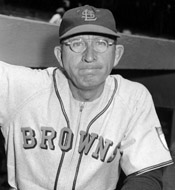
Zack Taylor
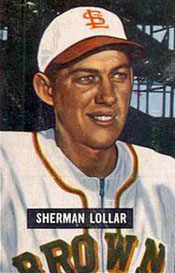
Sherm Lollar
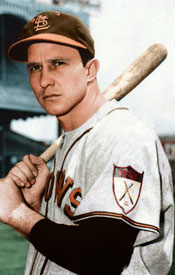
Roy Sievers
|
Ned Garver signed with the St. Louis Browns when he was 18 and fresh out of high school in rural Ohio.
- Ned had learned an effective changeup at age 18 in D ball. A good hitter, he often played the outfield and pinch hit.
- After he went 17-14 at AA San Antonio in 1947, he made the Browns' roster for the '48 season
Garver led the AL in losses in 1949 with 17 while toiling for the 7th-place Browns.
- After going 7-11 his rookie year, the second-year righthander won 12 games while completing exactly half of his 32 starts. His ERA was 3.98.
- In 1950, he tied Cleveland's ace, Bob Lemon, for the league lead in complete games with 22 while compiling a 13-18 record. He posted the AL's second-beat ERA at 3.39. He also led the Browns in hitting with a .286 average in 91 ABs.
1951 proved to be Ned's career year.
- Manager Zack Taylor had just two other quality players besides Ned: C Sherm Lollar and slugging 1B Roy Sievers, who had won the AL Rookie of the Year Award in 1949.
- Garver took the mound on opening day but didn't last past the six-run second as Chicago romped, 17-3.
- He bounced back to win his next three decisions, defeating Lemon 9-1, then garnering a victory in relief at Detroit before besting the Indians again, 6-3. Those three wins constituted the club's entire total after eleven games.
- In his next start, Garver pitched well but lost 2-0 to Boston.
Ned's next start demonstrates how different baseball was sixty years ago,
- He pitched all nine innings in a 13-10 victory over the Tigers.
- Far from tiring, he finished with three scoreless innings to move his record to 4-2.
- Despite 29 hits, the game lasted just 2:36.
Illustrating another difference from today's baseball, Ned appeared in relief just two days later.
- He allowed one run the last 4 1/3 innings of the 11-8 win over the Athletics in Philadelphia.
- Garver lost to Allie Reynolds at Yankee Stadium 6-1 before reeling off four straight victories.
- He beat Detroit 8-3, shutout Boston 4-0, and cruised against the A's 10-1. Then he endured another slugfest, giving up 18 hits but going the route in a 10-9 triumph over the Washington Senators. Taylor obviously felt more confident with a tired Garver holding a lead than any reliever he could bring in.
- If you aren't counting along at home, that made his record 9-3, giving him over half the Browns' 17 wins.
- On June 16, the Red Sox got revenge for his earlier shutout by scoring 10 runs on only 6 hits - but helped by seven walks - to end his winning streak, 9-5.
That month, the DeWitt family, long-time owners of the lowly Browns, sold the club to Bill Veeck.
- Garver got no decision again until July 1 when he beat the White Sox 3-1.
- He bested Chicago again five days later, 4-1.
- When the All-Star break came, Ned had accounted for exactly half of his team's wins.
- With an 11-4 record, Garver would have made the AL All-Star squad even if the rule requiring at least one player from every team were not in effect.
- Ned started the game, pitching the maximum three innings and allowing only one hit and an unearned run.
Reference: That One Glorious Season, Richard H. Letarte (2006)
Continued below ...
|
Ned Garver 1951 - II
This
feature discusses a season in which a team finished much higher
than they did in the immediate past or future or a player far surpassed any other year of his career.
Ned Garver entered the post-All-Star game season with an 11-4 record for the last place St. Louis Browns.
- He beat the Red Sox 3-1 on his first start, then twirled his fourth consecutive complete game, losing to the Yankees 1-0.
- Next, he beat the 7th-place Philadelphia A's 5-4 in another complete-game effort.
- He took the hill on July 31 in Fenway Park but had to lead in the fifth inning because he had pulled a leg muscle in the top of the inning while rounding first base after driving in two runs. The ageless Satchell Paige came in and got the victory.
Garver missed one turn but returned to action a week later.
- He lost to Yankees 6-2 as he started another complete game streak. His record was now 14-6.
- On August 19, Ned lost the first game of a DH against the Tigers 5-2. The second game that day saw the debut of Eddie Gaedel, a midget that owner Bill Veeck hired to add some spice to the game. Wearing uniform number 1/8, Eddie walked in his only ML at-bat, AL President Will Harridge ruling him ineligible the next day.
- Five days later, Garver had a more direct role in another of Veeck's stunts. Ned started the game in which the 1,115 fans behind home plate became managers, holding up signs saying yes or no to advise Manager Zack Taylor.
- After five of the first six batters reached base, the PA announcer asked the Grandstand Managers if the Browns should warm up a P. Most voted no. Ned rewarded their confidence with a 5-3 victory, his eleventh straight over the A's.
- The next game brought one of Garver's few shellings of the season, a 15-2 drubbing by the Yanks.
- He lost his second in a row to the Indians, 5-1. But five days later, he got revenge by beating Cleveland 4-2 to knock them out of first place.
- September 13 in Boston, he lost to Mel Parnell, 5-4. At 16-12, his chance of getting 20 wins seemed slim. But he won #17 in Washington on the 18th, 3-2.
- Four days later, he beat the White Sox, 5-1. Two to go to 20.
- Back home, he conquered the Tigers 7-1. One to go.
- He toed the slab on the final Sunday of the season. 12,000 turned out to root for Ned. Tied with the White Sox 4-4 in the bottom of the fourth, Ned hit his first homer of the year to give the Browns the lead for good. The 9-5 win put him in the select club.
- The last time a P had won 20 games for a last place team was 1924 when Hollis Thurston did it for Chicago.
Ned finished with a 3.79 ERA on team whose entire staff gave up 5.17 earned runs per contest.
- He led the league in complete games with 24.
- He also batted .305 in 95 ABs.
- Amazingly, he finished second to Yogi Berra in the MVP voting.
Garver was traded to Detroit near the end of the '52 season and pitched for them and the Kansas City Athletics through 1961. But his next best year was 1954 with the Tigers: 14-11 and a 2.81 ERA.
|

Ned Garver

Eddie Gaedel
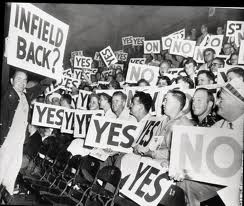
Bill Veeck's Grandstand Managers
|
Reference: That One Glorious Season, Richard H. Letarte (2006)
Top of Page
In 1954, 27-year-old James "Dusty" Rhodes of the New York Giants compiled these stats.
.341 BA, 15 HR, 50 RBI
The average is impressive, but what's so great about 15 HR and 50 RBI? Here's what's so great about them: he came to bat only 164 times in 82 games! He was used primarily as a left-handed pinch-hitter by manager Leo Durocher as the Giants won the NL pennant by five games over their hated rivals, the Brooklyn Dodgers. 50 RBI in 164 AB works out to an RBI every 3.28 times at the plate. And he homered every 10.9 ABs. By comparison, Babe Ruth leads all hitters with a career average of one HR every 11.76 AB.
Dusty's season wouldn't merit attention these many years later except for the role he played in almost single-handedly defeating the Cleveland Indians in four games in the World Series.
- Game One at the Polo Grounds: Rhodes hit a three-run pinch-hit HR in the bottom of the tenth for a 5-2 victory. The "blast" was just a high pop fly that dropped into the first row of the short (258') RF porch. Bob Lemon, the Indian hurler, threw his glove in disgust. Rhodes later joked, "Lemon's glove went further than my home run."
- The next day, Durocher called on Rhodes to pinch hit in the fifth inning for LF Monte Irvin with runners on first and third. Dusty's single to CF off Early Wynn scored Willie Mays to tie the score 1-1. The Giants scored another run in the inning to take the lead. Then in the seventh Rhodes hit another HR to right for an insurance run in the 3-1 triumph.
- In Cleveland for Game 3, Rhodes again pinch hit for Irvin, this time in the third inning with the bases full. Dusty smacked a two-run single off the third of Cleveland's right-handed aces, Mike Garcia, to key a three-run rally that put NY up 4-0. The Giants took command of the Series with a 6-2 victory.
- Rhodes wasn't needed in the Giants' 7-4 win over the shell-shocked Indians in Game 4.
Dusty finished the Series 4-for-6 (.667) with two runs scored and seven batted in. His two HRs were the only ones hit in the Series. His OBP was .714 and his slugging pct. was 1.667.
Rhodes got into baseball by luck. Recently discharged from the Navy after World War II, Dusty played in a pickup game in Montgomery AL in 1946. He hit several HRs and a triple on a day when a scout for Nashville of the Southern Association happened to see him and signed him to a contract on the spot. Not much of a fielder, his hitting still brought him to the Giants in 1952. (Twenty years later, Rhodes would have made a marvelous DH.) He hit .250 and .233 before his breakout in '54. In his autobiography, Durocher called Rhodes the "worst fielder who ever played in a big league game." However, he also said, "Dusty was the kind of buffoon who kept a club confident and happy. Between him and Mays, there was nothing but laughter in our clubhouse all season. Pressure? They spit at it!'
Perhaps the most amazing aspect of the Alabama-born Rhodes' tenure with the Giants was his friendship with fellow-Alabamian Mays and other black players like Irvin and Hank Thompson. SS Alvin Dark from Louisiana and Whitey Lockman from North Carolina also had no problems with their black teammates. Rhodes: "To be honest, we never thought a thing about it. In my case, I grew up with blacks. We picked cotton side-by-side."
Rhodes, a hard drinker, often missed curfew. But Durocher tolerated his malfeasance because Dusty was never late to the ballpark, and he could hit no matter how much or how little sleep he got. It didn't hurt Rhodes's cause that one of his most frequent drinking companions was Giants owner Horace Stoneham.
Dusty played four more ML seasons, including a last one in San Francisco, but never hit double-digit HRs in any of them.
|
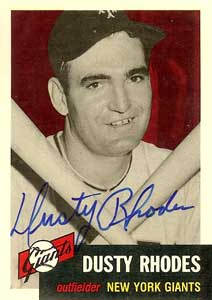
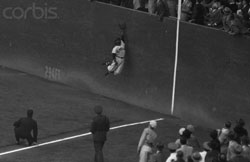
Rhodes' Game One HR barely makes it into the bleachers.

Bob Lemon
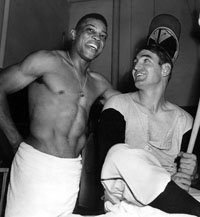
Willie Mays and Dusty Rhodes after Game One
|
Reference: "Dusty Rhodes Recalls His Short-Lived Big League Career," Baseball Digest, May 2009
Top
of Page
|
|
|
In 1964, 19-year-old rookie P Wally Bunker of the Baltimore Orioles went 19-5 to win the AL Rookie Pitcher of the Year award. All his stats were impressive that year.
2.69 ERA, 12 CG, 214 IP, 161 H, 96 K, 62 W
Throwing a great sinker, the Seattle native who grew up in California quickly became the ace of manager Hank Bauer's staff. Milt Pappas trailed Bunker with 16 victories while veteran Robin Roberts added 13 as the O's finished a surprising third, one game behind the White Sox and only two behind the Yankees.
Bunker's season had a number of highlights.
- He scored his first big league victory over Washington, whose veteran players, especially Moose Skowron, rode him unmercifully. However, Wally soon earned their respect by the way he pitched. Around the sixth inning, Skowron told one of the Oriole coaches, "Tell the kid he's OK." OK indeed as he twirled a one-hitter.
- That was the first of six straight victories for the rightie from Seattle.
- In tribute to the instant fan favorite, the Baltimore mayor in June rechristened the pitching mound at Memorial Stadium "Baltimore's Bunker Hill" with a handful of soil from Boston's Bunker Hill. Wally thanked the big crowd, then pitched the Orioles into first place with a 6-1 victory over the league-leading White Sox.
- Soon after that, he threw his second one-hitter.
Wally's success was destined to be short-lived.
- While pitching on a cold September night in Cleveland, Bunker winced in pain. "I thought somebody had shot me in the shoulder with a .22 rifle," he says.
- He probably suffered torn ligaments or tendons, but arm ailments often went undiagnosed in those days. He was never the same P again.
Bunker struggled through four more seasons with Baltimore.
- He won 10 games in both '65 and '66 but only five in '67-'68 combined.
- Wally did start and win Game 3 of the World Series, pitching a 1-0 shut out against the Los Angeles Dodgers as part of the Orioles' sweep.
- He was taken in the 1969 expansion draft by Kansas City and threw the first pitch in Royals history.
- After compiling a 14-25 record in three seasons with KC, Bunker retired after the 1971 season.
|
|
|
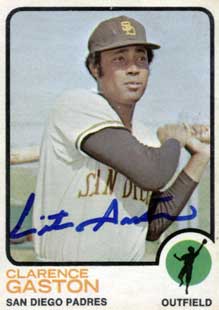
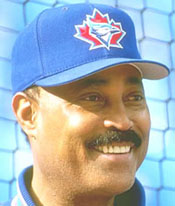
Top
of Page
|
Rookie OF Cito Gaston played 25 games in 1967 with the Atlanta Braves, where he roomed with the great Henry Aaron.
- After a year in the minors, Cito was taken in the 1969 expansion by the San Diego Padres.
- He had a nondescript '69 season. Playing 130 games, mostly in CF, Gaston hit only .230 with only 2 HR and 28 RBI.
Cito exploded in 1970 for his career year.
.318, 93 RBI, 26 2B, 9 3B, 29 HR
- He made the NL All-Star team and even got 5 points in the MVP voting at the end of the season. However, the Padres still finished last (sixth) in the NL West.
- The next year he slumped to .228, albeit with 17 HR, before rebounding to .269 in '72 and .250 with 16 HR in '73. He finished his stint with the Padres with .213 in 1974.
- Prior to the '75 season, he was traded back to Atlanta for Danny Frisella. Over the next three seasons, he never appeared in more than 69 games for the Braves. His best average was .291 in '76.
- Gaston was sold to the Pittsburgh Pirates during the '78 season, the final one of his career.
Gaston is remembered by baseball fans for managing the Toronto Blue Jays to back-to-back World Series championships in '92-'93.
- Tito became Toronto skipper during the 1986 season after coaching under Bobby Cox there for four years.
- He led the Blue Jays to first-place finishes in the AL East in five of the next six years. The other year ('90), they finished second.
- In '92, Cito defeated his mentor, Cox, of the Braves in the World Series.
- The next season, Toronto bested Jim Fregosi's Philadelphia Phillies.
- When the Pride of Canada began losing their pennant-winning players, the team sank in the standings until Gaston was fired after the '97 season.
- He returned during the 2008 season for his second tour as Blue Jay skipper.
Final tidbit about Gaston: Although his given name is Clarence, he got the name "Cito" from a Mexican wrestler that he used to watch while growing up in Texas.
|
|
In 2001, Bret Boone of the Seattle Mariners had the best season by a 2B in American League history.
.331 BA, 37 HR, 141 RBI
The 141 RBI led the league and set an AL record for 2B. His 37 round-trippers also established a new AL 2B mark. Bret never had more than 117 RBI (2003) in any of his other 13 ML seasons. He made the 2001 All-Star team, won a Silver Slugger award, and finished 3rd in the MVP voting. Lou Piniella's Mariners won 116 games to break the 1998 Yankees' league record of 114. Seattle won the AL West by 14 games over Oakland, which had the second most wins in the league. However, the Mariners did not make the World Series as the Yankees eliminated them in five games in the ALCS.
In the six seasons immediately preceding his breakout 2001 campaign, Boone had these numbers.
- 1995 with Cincinnati: .267/15/68
- 1996 with Cincinnati: .233/12/69
- 1997 with Cincinnati: .223/7/46
- 1998 with Cincinnati: .266/24/95
- 1999 with Atlanta: .252/20/63
- 2000 with San Diego: .251/19/74
Bret's HRs and RBI spiked in 1998, but otherwise these numbers are journeyman caliber. His productivity dropped sharply after the 2003 season, which happened to coincide with baseball's new drug testing policy. You can speculate whether that was coincidence or that his age (35) began to catch up with him.
Boone retired after the 2005 season with 252 HRs, which places him sixth all-time among 2B behind Jeff Kent, Ryne Sandberg, Rogers Hornsby, Joe Morgan and Joe Gordon. All but Kent are in the HOF and Jeff will be when he is eligible.
|
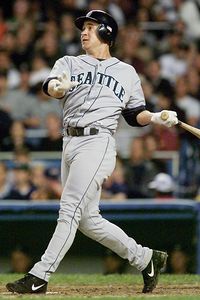
Bret Boone
Top
of Page
|
|
Washington Senators 1912-13
|
|
This edition of this feature is better termed, "Two Great Years."
- A charter member of the American League in 1901, the Washington Senators finished sixth the first two years, then did worse.
- From 1903-1911, Washington finished last (eighth) four times and seventh five times.
So no one, not even their staunchest supporters, expected what happened the next two years.
- Clark Griffith replaced Jimmy McAleer as manager for 1912 and immediately instilled a new spirit in the club.
- After winning only 64 games in 1911, the Senators amassed 91 victories the next season to finish second, 14 games behind the Boston Red Sox.
- Four rookies added youth to Griffith's starting lineup. However, none of them would be Hall of Fame caliber.
- RF Dan Moeller hit .276 on his way to a .243 lifetime ML mark. As was typical in the Dead Ball Era, Moeller led the team in HR with a mere 6.
- 3B Kid Foster hit .285. However, his career is best known for the longest streak of homerless ABs in ML history – 3,278.
- LF Hank Shanks hit only .231.
- Part-time 2B Ray Morgan posted a .238 mark.
- The mainstays of what came to be called the "Cinderella Eight" were a second-year player and a five-year veteran.
- Sophomore 1B Chick Gandil batted .305 and drove in 81 runs. Gandil would gain fame at the end of the decade as one of the leaders of the Chicago Black Sox.
- CF Clyde Milan hit .306, drove in 79 and led the league with 88 SBs, quite a feat in the heyday of Ty Cobb, who pilfered only 64. Clyde would finish fourth in the MVP voting at the end of the year
Milan epitomized the main new element Griffith emphasized – speed.
- The team went from 215 SB in '11 to 273 in '12.
- The club batting average decreased slightly from .258 to .256 but run-production increased from 623 to 698, indicating better movement of runners and clutch hitting.
To finish second, a team needs solid pitching, and that's where the Senators best player – and only future HOFer besides the manager – comes in. In his sixth year with the club, Walter Johnson hurled at the peak of his powers.
- After winning 25 in both 1910 and 1911, The Big Train put 33 W's on the board, 36% of the team's total.
- Johnson led the league in ERA with 1.39 and strikeouts with 303. He finished third in the MVP voting behind Tris Speaker and Ed Walsh.
- Another RHP, Bob Groom, gained 24 wins with a 2.62 ERA. The next best starter was Tom Hughes with 13 victories.
Griffifth's boys started the season like the same old Senators, then caught fire.
- After losing the first game of a DH on May 30, Washington stood at 17-21.
- The team then reeled off 17 wins in a row, the first 16 of which came on the road!
- Now 34-21, the Senators ran second, only 1.5 behind the Red Sox. However, that would prove to be the closest to first the team attained for the season.
- Four straight losses in Philadelphia to the A's pushed Washington into fourth place.
- But after losing 10 of 14, the Nationals (as they were also called in those days) tore off 10 in a row to return to second place. This became a 16-3 stretch.
- The team never fell lower than third the rest of the way. They nosed out Connie Mack's Athletics by one game for the runner-up spot.
Washington proved that 1912 was no fluke by finishing second again in 1913 with basically the same roster. Milan again led the circuit in SBs.
- The A's won the pennant while Boston dropped to fourth.
- Griffith's squad slowly slipped in the standings after that: third in 1914, fourth in 1915, then seventh.
- The Senators would finally win the pennant in 1924 and 1925 in the twilight of Johnson's career.
Reference: The Upstart Senators of 1912-1915," Guy Waterman, The National Pastime, 1993
|
|
|
Wes Parker 1970
Entering the 1970 season, Wes Parker of the Los Angeles Dodgers, in his own words, "was getting so tired of people saying that [I] was a great fielder but a poor to average hitter. .... I wanted to let people know that I could hit."
- He had won the Gold Glove for 1B three straight years (and would win it the next three as well). His fielding averages were amazing.
- 1967: .996 (4E in 112G)
- 1968: .999 (1E in 114G)
- 1969: .996 (6E in 128G)
- Yet his offensive production was not up to par of what was expected from first-sackers.
- 1967: .247, 31 RBI, 5 HR
- 1968: .239, 27 RBI, 3 HR
- 1969: .278, 68 RBI, 13 HR
Wes attributes his '69 improvement to hitting coach "Dixie" Walker, who corrected mechanical flaws in his swing. "I was an uppercut swinger."
- Parker also credits Tommy Lasorda for giving him a more positive outlook during spring training of 1970.
- A minor league coach at the time, Lasorda "said I had the physical attributes of eyesight and coordination, and he convinced me I could be just as good a hitter as I was a fielder."
Wes decided to eliminate all distractions during the season and focus on baseball.
- A bachelor, he gave up dating completely. "It was interfering with focus. I didn't answer the phone hardly at all, because I didn't want to know anything about leaving tickets for people ... So I pretty much became a recluse and hermit."
- On the road and at home, he spent more time in bed. Then he'd report to the ballpark earlier to relax and get himself focused for the game.
- "I used to take a little ten-minute nap before the game. Not that I fell asleep. ... I'd just think about who was pitching against us that night and how I was going to get hits off him."
Parker's dedication paid off.
- He produced these figures for 1970, all career highs:
161 games, .319 BA, .392 OBP, 47 doubles, 111 RBI
- The 47 doubles led the National League.
- The Dodgers climbed from 4th to 2nd in the NL West.
Wes played two more years, retiring at the relatively early age of 32.
- 1971: .274, 24 2B, 62 RBI
- 1972: .279, 14 2B, 59 RBI
Why the dropoff? What happened to all that focus?
- "After doing that for one season, I decided it wasn't worth it ... I caught colds again ... I was distracted. I started doing drug talks to kids ... Leaving passes for people, having girls at the games and going out with them afterwards. Now some people can do all that and still play good baseball. I can't."
- "It was a conscious decision on my part that the sacrifices and effort, the amount of energy that had to go into it, was more than I thought it warranted. 1970 was for one season only. I'm glad I did that once, but I wanted to enjoy all aspects of my career, part of which was dating again, part of which was enjoying people. I didn't want to live like a hermit again ..."
When it came to background and interests, Wes Parker was not your average ballplayer.
- Born to millionaire parents, he grew up with classical music in his home. He also loved to read and aspired to be a writer.
- After retirement, he became a color commentator on baseball games and still works for the Dodgers community relations department. He also did some acting and collected art and rare books. He wrote short stories and dreamed of writing a baseball novel.
- After one year out of baseball, he played a season in Japan because he wanted to experience a new culture.
But for one season, 1970, Wes Parker was all baseball player, not Renaissance Man.
|
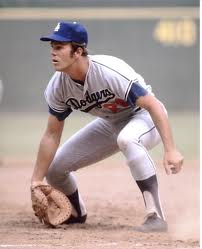
Wes Parker

Dixie Walker

Tommy Lasorda
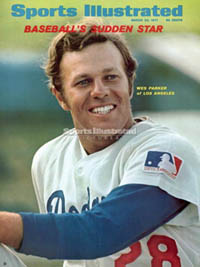
|
|
Joe Charboneau
It didn't take long for the legend of Joe Charboneau to form in Cleveland.
- Signed by the Phillies, he quit baseball in his second minor league season because of clashes with management.
- Given a second chance, he hit .350 in class A ball in 1978. But after a barroom brawl, he was traded in the off-season to the Indians.
- Cleveland moved him up to AA where he kept up his torrid pace at .352.
- So he arrived at the Indians' 1980 spring training with questions about whether he could produce anywhere close to those numbers in the Big Show.
- Before the end of spring ball, he was already called "Super Joe." On March 28, he hit his fourth HR of the spring and was batting .380. One scout called the 24-year-old right-handed batter "one helluva hitter, a natural with power." Another described him as "a good, solid hitter. He hits the ball on the sweet part of the bat."
- But bizarre events began to happen to him. When the Indians played several games in Mexico City, a man stabbed Joe in the side with a ball-point pen outside the hotel after Joe refused to sign an autograph.
- Joe's hitting overrode his shaky fielding and weak arm. After losing his best outfielder, Andre Thornton, to a knee injury, Manager Dave Garcia installed Charboneau in LF for the season opener.
- Fans began wondering whom the Indians traded to Philadelphia to obtain Super Joe. The answer was Cardell Camper, who was cut by the Phillies farm system. For once, a franchise that hadn't finished higher than 4th since 1968 had put one over on another club.
Charboneau kept on hitting when the season started.
- He hit .354 in April and, though he couldn't maintain that pace, he ended the season at .289 while leading the team in HRs with 23 and RBIs with 87. His slugging % of .488 also topped the Tribe.
- The highlight of his year was a homer into the third deck of Yankee Stadium on June 28. Only two players had previously reached that section: Jimmie Foxx and Frank Howard. Joe later recalled the blast:
I remember it like it was yesterday. Tom Underwood, a left-hander, was pitching for the Yankees. It was the first time I ever faced him, and I got ahead in the count 3-and-1, and looked for a fastball in, which I got. I swung, and I never hit a ball better. As I was going around 2B, I looked up to where the ball landed and thought to myself that I'd probably never hit another ball like that again. And I never did. It was a once-in-a-lifetime swing. Later they told me it was one of the three longest HRs ever hit in Yankee Stadium. Imagine that! Yankee Stadium, the "House That Ruth Built." The whole thing was unbelievable. It seemed like the ball carried forever.
- His performance earned him the AL Rookie of the Year award in a runaway with 73% of the votes.
- A song was written about him.
Who's the newest guy in town?
Go Joe Charboneau.
Turns the ballpark upside down.
Go Joe Charboneau.
Who's the one to keep our hopes alive, straight from seventh to the pennant drive?
Raise your glass, let out a cheer for Cleveland's Rookie of the Year!
|


Dave Garcia
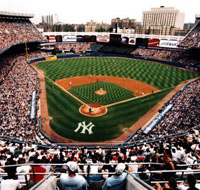
Third deck in LF in old Yankee Stadium
|
Along the way, though, Joe earned a reputation for flaky behavior, including the following real or imaginary events:
- Opening beer bottles with his eye socket.
- Shaving his head a decade before that became fashionable.
- Cutting off a tattoo with a razor blade
- Eating cigarettes
- Fighting in boxcars for $25/match
But by mid-season 1981, he was back in the minors.
- He hurt his back sliding into 2B head first during spring training.
It had rained that morning, and I basically kind of stuck in the dirt. My legs kicked back over my head, and I knew I did something. I had a lot of pain, and foolishly I continued to play. But I didn't have the same swing, and I never got it back.
- The problem was never cured despite two operations.
- In only 48 games with the Indians in '81, he hit just .210 with 4 HRs. He was sent to the minors just as a boot titled Super Joe: The Life and Legend of Joe Charboneau came out. According to Joe, the book is an easy read with plenty of fun stuff in it, though a lot of the stories are only minimally true, some are greatly exaggerated, and others were never true to begin with.
- He hurt his back again in '82 when 22 games produced only 2 HRs, 9 RBIs, and a .214 average.
- After 11 games with AAA Buffalo in '83, during which he hit only .200, he gave an "obscene salute" to the fans and was immediately released.
Sure, I have a lot of regrets, but no complaints about anybody, and no bitterness. I always knew an injury could happen and, for me, it did. Somebody wrote an article about me in 1980, and I said that all I really wanted to do was stay healthy. But I didn't.
Reference: " Joe Charboneau," Baseball: The Biographical Encyclopedia (2000)
Whatever Happened to Super Joe? Catching Up with 45 Good Old Guys
from the Bad Old Days of the Cleveland Indians, Russell Schneider
Top of Page
|
|




